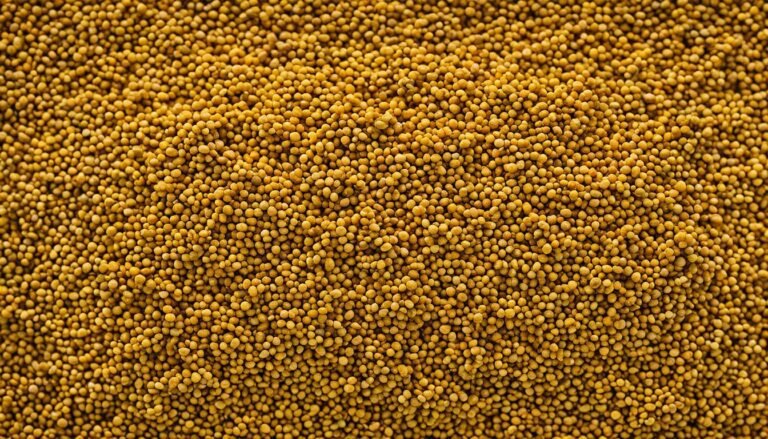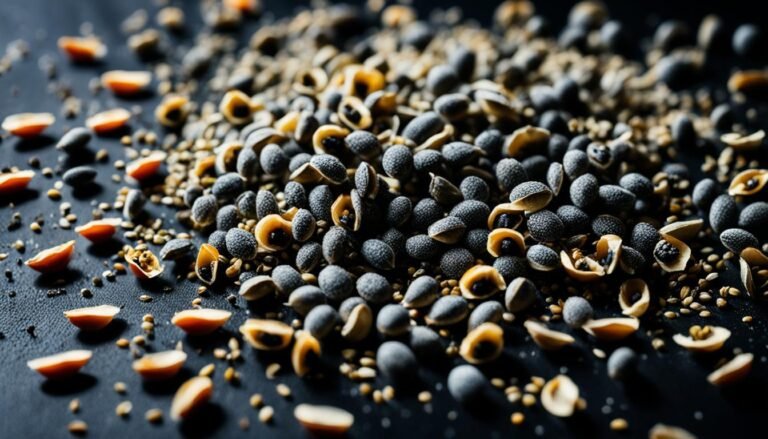Health Benefits of Amaranth Seeds: A Superfood Guide

Did you know one cup of amaranth seeds has 20 grams of fiber? This is more than the daily recommended amount for both men and women. Amaranth, an ancient Aztec superfood, means “unfading” in Greek. It’s packed with nutrients and can be added to many dishes.
It’s gluten-free, high in protein, and full of antioxidants. Amaranth also helps your heart. It’s a superfood that should be part of a healthy diet.
Learn about the health benefits of amaranth and how to add it to your meals. This guide will show you how to make the most of this amazing grain. Discover the secrets of amaranth, the superfood that’s good for you.
Introduction to Amaranth Seeds
The Unfading Superfood
Amaranth is an ancient superfood with a long history. It was first grown over 8,000 years ago. Many civilizations, like the Aztecs, made it a key part of their diet. The name “amaranth” comes from the Greek word “amarantos,” meaning “unfading,” which refers to its lasting flowers.
Now, amaranth is grown all over the world. You can find it in places like China, Peru, Nigeria, Mexico, and more. Its great nutrition and many uses in cooking have made it a superfood. It’s packed with vitamins, minerals, and antioxidants, making it a top choice for health.
| Nutrient | Amount per Cooked Cup (246g) | % of Recommended Daily Intake (RDI) |
|---|---|---|
| Calories | 251 | – |
| Protein | 9.3g | – |
| Carbohydrates | 46g | – |
| Fat | 5.2g | – |
| Manganese | – | 105% |
| Magnesium | – | 40% |
| Phosphorus | – | 36% |
| Iron | – | 29% |
| Selenium | – | 19% |
| Copper | – | 18% |
The amaranth superfood is known for its amazing nutrition and history. It’s grown all over the world. This grain is full of nutrients and is great for health. It’s a superfood that offers many benefits for well-being.
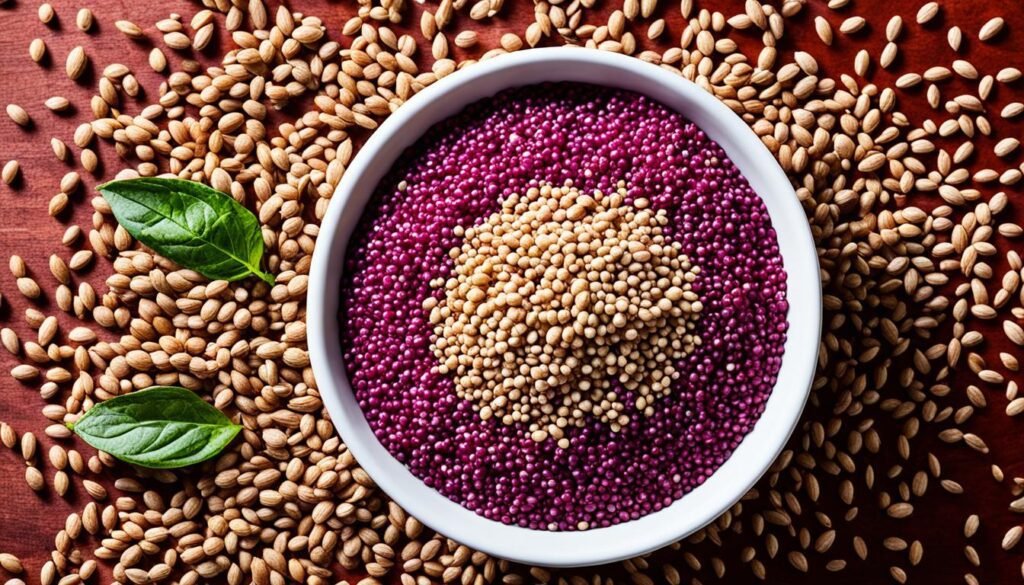
Gluten-Free and Protein-Rich
Amaranth is a great choice for those who need a gluten-free diet. It doesn’t have the gluten protein found in wheat, rye, and barley. This makes it safe for people with celiac disease or gluten sensitivity. Plus, it’s packed with plant-based protein, having almost twice as much as corn or rice.
This superfood’s protein is easy for your body to use. It has all the essential amino acids, including lysine, which is rare in grains. This makes amaranth perfect for vegetarians or vegans, offering a complete protein source.
| Nutrient Comparison | Amaranth | Quinoa |
|---|---|---|
| Calories (per cup) | 251 | 222 |
| Protein (grams per cup) | 9.3 | 8 |
| Fiber (grams per cup) | 5.2 | 5.2 |
| Iron (% of daily value per cup) | 29% | 15% |
| Magnesium (% of daily value per cup) | 38% | 30% |
| Manganese (% of daily value per cup) | 91% | 58% |
The table shows amaranth beats quinoa in many nutrients like protein, iron, magnesium, and manganese. Adding amaranth to your meals can help increase your protein intake and meet your nutritional needs. It also helps avoid gluten.
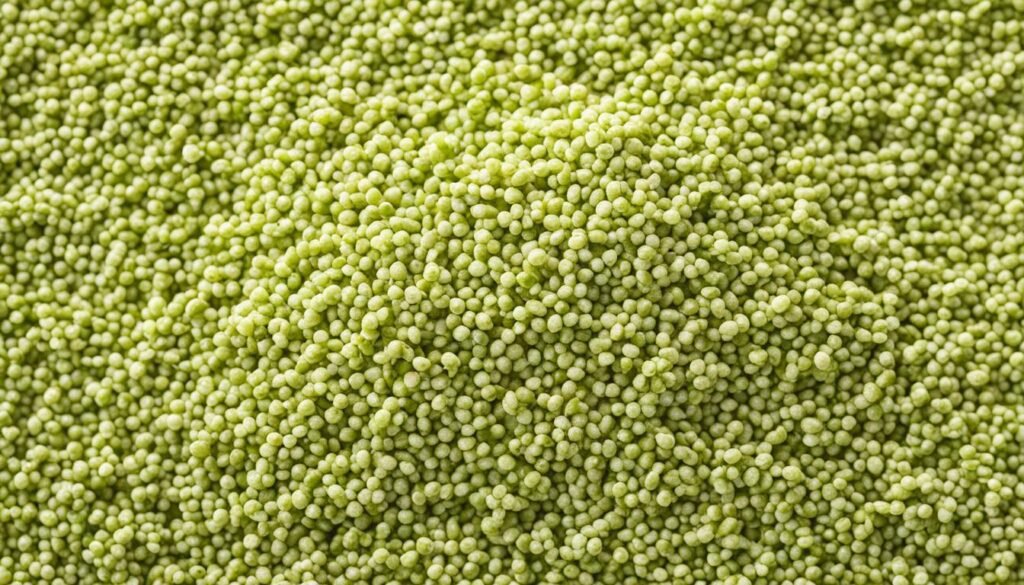
Antioxidant Power
Amaranth is an ancient superfood packed with antioxidants. These help fight the bad effects of free radicals in your body. Gallic acid and vanillic acid are key antioxidants in amaranth. They neutralize free radicals, which can cause aging and increase the risk of diseases like heart disease.
Studies show that green morph amaranth has a strong antioxidant capacity. It ranges from 27 to 48 μg g−1 Trolox equivalents. It also has important minerals like potassium, calcium, magnesium, iron, manganese, copper, and zinc. Four types of green morph amaranth are especially rich in these antioxidants.
Fighting Free Radicals
Eating amaranth antioxidants can lower oxidative stress and inflammation in your body. Amaranth gallic acid and amaranth vanillic acid help neutralize free radicals. This protects your cells and supports your health and well-being.
| Nutrient | Amaranth | Oats |
|---|---|---|
| Protein (g per cup) | 28.1 | 26.1 |
| Calcium (% of RDI) | 200% | 10% |
| Iron (g per cup) | 5 | 2.4 |
Adding this superfood to your diet can boost your body’s defenses against oxidative stress and inflammation. Using the antioxidant power of amaranth is a step towards better health and well-being.
Health Benefits of Amaranth seeds
Anti-Inflammatory Properties
Amaranth is known for its strong anti-inflammatory effects. It can ease pain from different conditions. Studies reveal that amaranth slows down the body’s production of immunoglobulin E, a key inflammatory factor.
This means eating amaranth may lessen inflammation from allergies and other disorders.
Cardiovascular Health
Amaranth seeds are good for the heart. Studies in animals show they lower “bad” LDL cholesterol without affecting “good” HDL cholesterol. This could make amaranth a great choice for heart health, lowering the risk of high cholesterol and heart disease.
However, more studies are needed to prove these benefits in humans.
One-fourth cup of dry, uncooked amaranth grains contains:
| Nutrient | Amount |
|---|---|
| Calories | 179 kcal |
| Carbohydrates | 31 g |
| Protein | 7 g |
| Fats | 3 g |
| Fiber | 3 g |
| Sugar | 1 g |
Amaranth is packed with protein and is gluten-free, perfect for those with gluten allergies. It’s also full of vitamins, minerals, and antioxidants, making it a nutritional powerhouse.
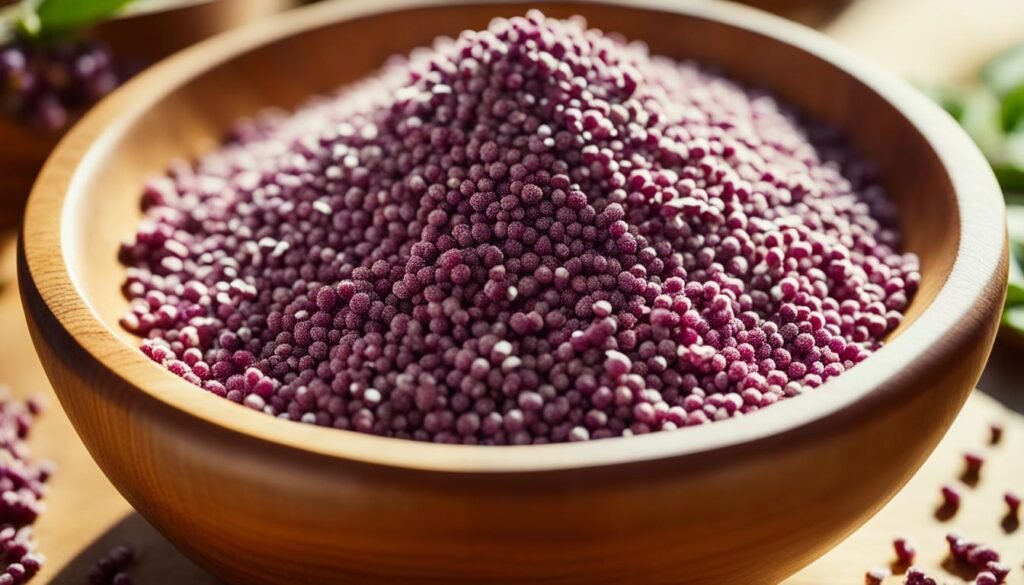
Nutritional Powerhouse
Amaranth is a nutritional powerhouse, full of essential vitamins and minerals. It’s gluten-free and high in protein. Plus, it offers a lot of nutrients that help keep you healthy.
Essential Vitamins and Minerals
A quarter-cup of dry, uncooked amaranth nutrition gives you a lot of manganese. Manganese helps with over 300 body reactions. Amaranth is also packed with amaranth vitamins like protein, fiber, iron, magnesium, phosphorus, and B vitamins.
These amaranth minerals make amaranth great for a healthy diet. Amaranth seeds have all the amino acids your body needs. They also have a lot of fiber, which helps with blood sugar, digestion, and weight control.
- Amaranth is high in protein, providing 9 grams per cup of cooked grain – more than quinoa or brown rice.
- A cup of cooked amaranth fulfills around 22% of your daily magnesium needs, a mineral essential for bone health and muscle function.
- Amaranth is rich in iron, offering 6 milligrams per cup, almost half the recommended daily intake.
- The grain contains antioxidants like squalene and phenolic compounds that help neutralize harmful free radicals.
Amaranth is truly a nutritional powerhouse. Adding it to your diet can greatly improve your health and well-being.
Versatility in the Kitchen
Amaranth is a versatile ingredient that can be enjoyed in many ways. You can boil the whole grain to make a nutritious cooking with amaranth porridge. Or, add it to soups and stews for extra texture and flavor. For a crunchy snack, pop amaranth like popcorn.
Amaranth flour, made by grinding the seeds, is a great gluten-free flour alternative. This flour is packed with nutrients. Use it to bake amaranth recipes like breads, muffins, and pastries. It gives classic baked goods a wholesome twist.
The leaves of the amaranth plant are also edible. Sauté them or add them raw to salads for a tasty, nutritious boost. You can also sprinkle the small seeds on dishes for a crunchy topping that adds flavor and nutrition.
Amaranth has a mild, nutty taste that fits well in many dishes. Whether you’re making a hearty soup, baking bread, or creating a fresh salad, amaranth is a versatile ingredient. It can make your recipes more nutritious.
| Amaranth Nutrient Profile | Amount per Cooked Cup |
|---|---|
| Carbohydrates | 46 grams |
| Protein | 9 grams |
| Fiber | 5 grams |
| Calories | 250 calories |
Cultivation and Availability
Amaranth is known for its nutritional value and versatility. But have you thought about how it goes from farm to table? Let’s look into how this amazing grain is grown and found in stores.
Seasonal Harvesting
Amaranth grows best in midsummer until the first frost. The seeds are ready when they fall off easily when you roll them in your hands. You can dry them or use them fresh. Make sure to store them in a sealed container to keep their taste and nutrients.
You can find dried amaranth seeds all year in many stores. Look for them in South American grocery stores, health food shops, farmers’ markets, and big supermarkets. Amaranth is getting easier to find for those who want to eat healthier.
Amaranth is easy to grow, making it a great choice for farmers. The Plainsman variety grows well in places like Missouri, producing up to 2,000 pounds per acre. It costs about the same to produce as other grains and can be farmed with regular equipment. This makes amaranth a smart choice for farmers.
If you want to add amaranth to your cooking or find a good source for it, you’re in luck. This ancient grain is becoming more popular for its health benefits. It’s easy to find and grow, making it a top pick for those who care about their health.
Incorporating Amaranth into Your Diet
Amaranth is a superfood that’s easy to add to your diet. It’s great for both savory and sweet dishes. Let’s look at some tasty ways to include amaranth in your meals and snacks.
Amaranth Porridge
One way to enjoy amaranth is by making a porridge. Mix one part amaranth with two parts water or plant-based milk. Bring it to a boil, then simmer for 20-25 minutes, stirring now and then, until it’s soft and creamy.
Top your porridge with fresh fruit, nuts, honey, or cinnamon. It’s a nutritious and comforting breakfast.
Popped Amaranth Snacks
You can also pop amaranth seeds like popcorn for a crunchy snack. Heat a small amount in a skillet over medium-high heat, stirring constantly. They’ll start popping and puffing up.
Popped amaranth is great on yogurt, salads, or as a healthy snack on its own. It’s a tasty alternative to chips or crackers.
Baking with Amaranth Flour
Amaranth flour is a gluten-free option for baking. Use it in place of all-purpose flour in recipes. Just remember to adjust the liquid a bit. It adds a nutty flavor and more nutrition to your baked goods.
Sautéed Amaranth Greens
Don’t forget about the amaranth leaves! Sauté them with oil, garlic, and seasonings. They’re perfect as a side dish or in stir-fries, soups, and other meals.
Amaranth is a superfood that’s easy to add to your diet. Enjoy it in porridge, as a snack, in baked goods, or sautéed with veggies. It brings flavor, texture, and essential vitamins and minerals to your meals.
Precautions and Considerations
Amaranth is usually safe and nutritious to add to your meals. But, there are some things to remember. If you’re sensitive to certain foods, amaranth might cause discomfort or bad reactions. Start with small amounts and watch how your body reacts.
Amaranth side effects might be bloating, gas, or diarrhea if you’re sensitive. It also has a lot of vitamin K. This could affect people taking blood-thinning drugs. Always talk to your doctor before eating more amaranth if you’re on these medications.
If you’re allergic to amaranth, be careful and watch for allergic signs like hives or trouble breathing. Start with a little bit and see how you feel before eating more.
Overall, amaranth safety is well-known. It’s a superfood that’s good for you. Just start slow and watch your body’s response. This way, you can enjoy all the health benefits amaranth offers safely.
Conclusion
Amaranth is a superfood packed with nutrients. It’s high in protein and gluten-free, making it great for health. It also has antioxidants and can help your heart.
This grain is easy to add to many dishes, like breakfast porridges and baked goods. Adding amaranth to your meals boosts your health and well-being.
Studies show amaranth can fight inflammation and support heart health. It’s been eaten for thousands of years. Now, it’s seen as a solution for global health and food issues.
Using amaranth in your cooking means you’re eating well and helping the planet. It’s a win-win for your health and the environment.
In short, amaranth is a superfood you should eat. It’s good for your health, easy to use in cooking, and helps the planet. Try adding it to your meals to improve your health and support a better food system.


